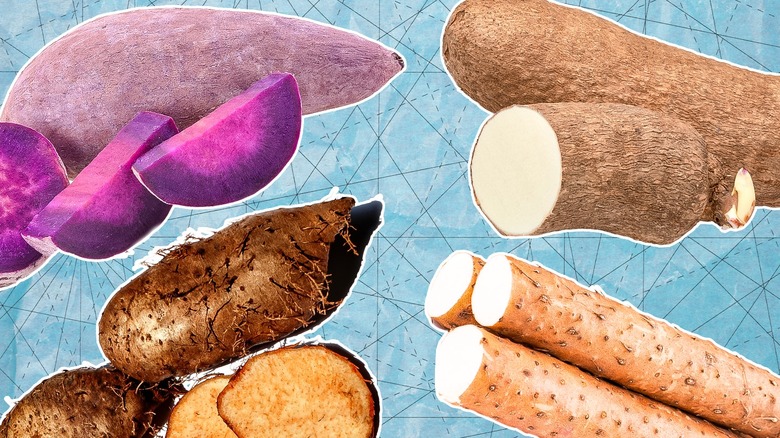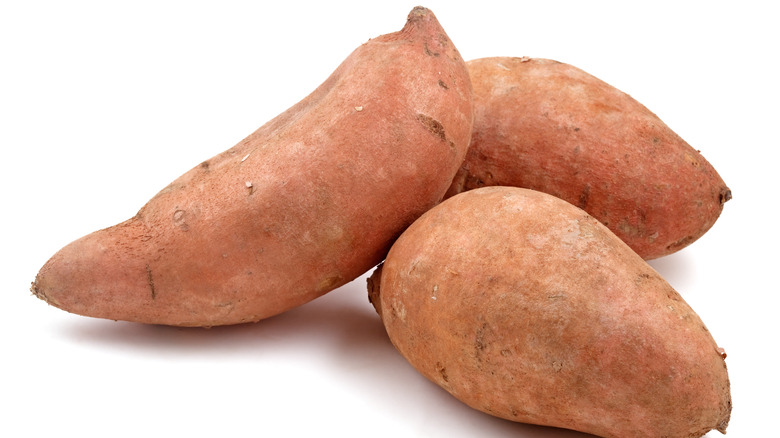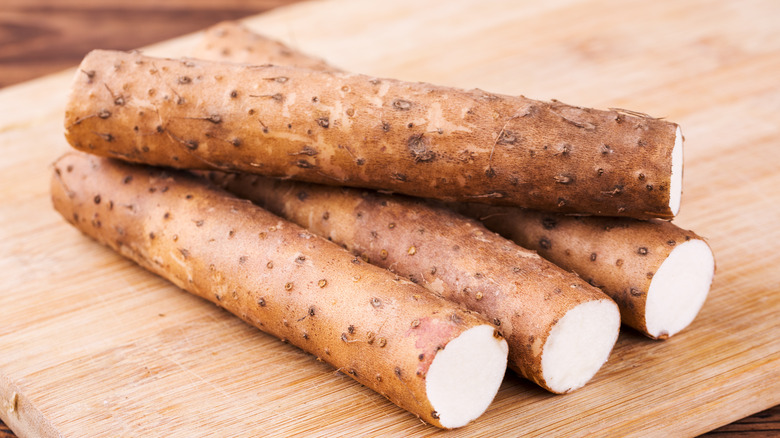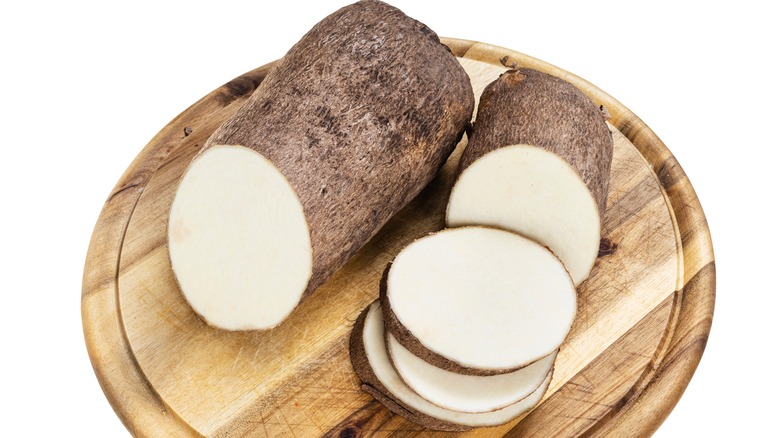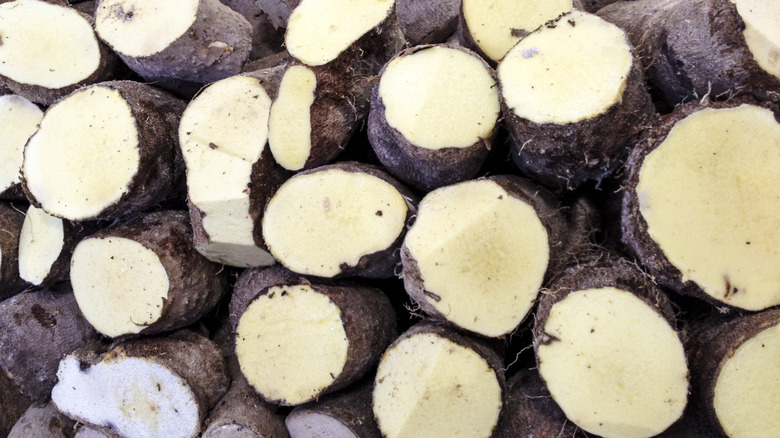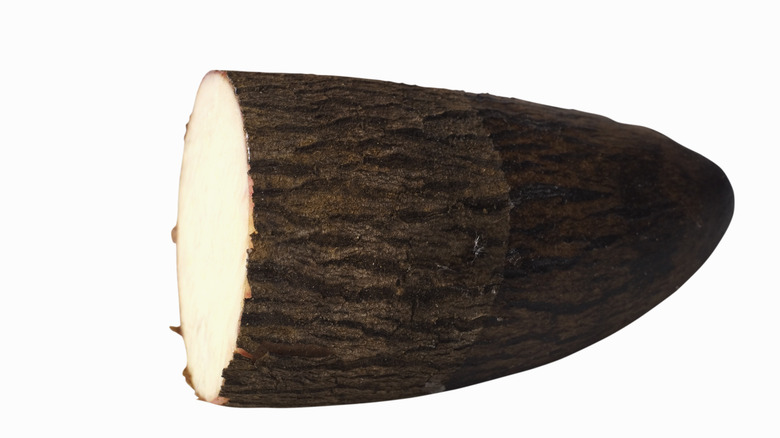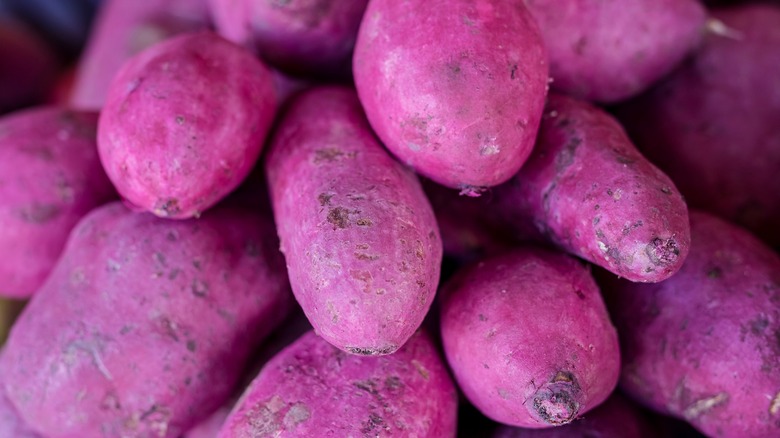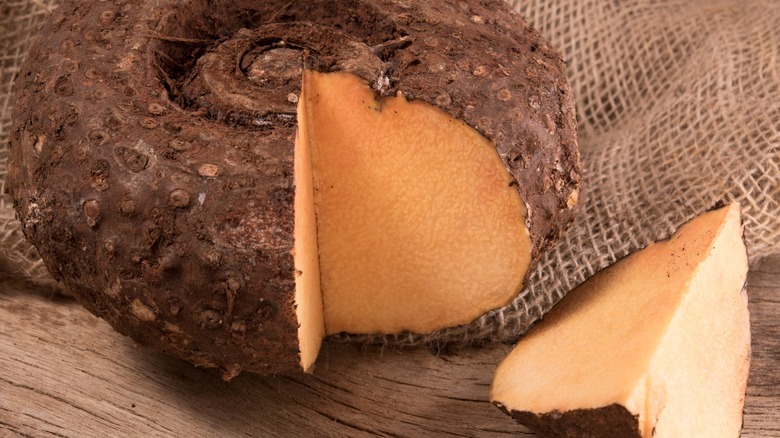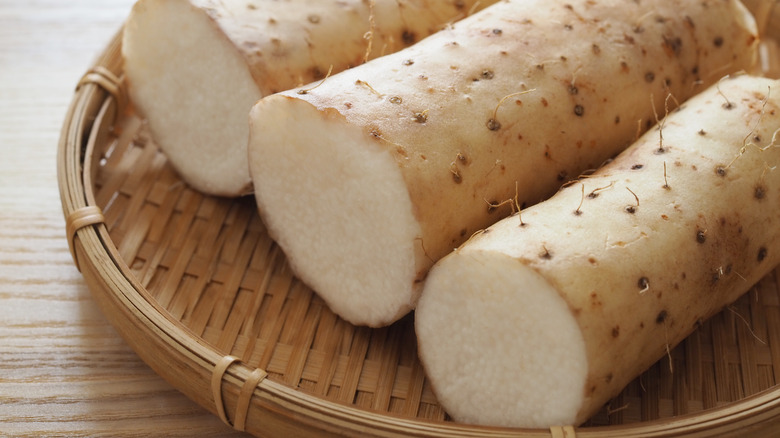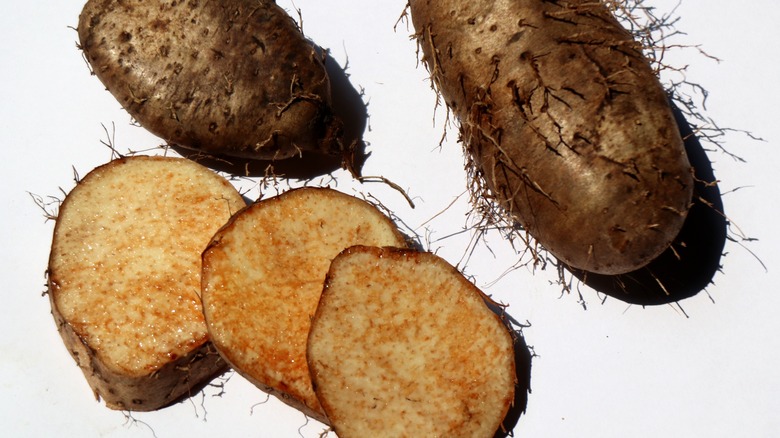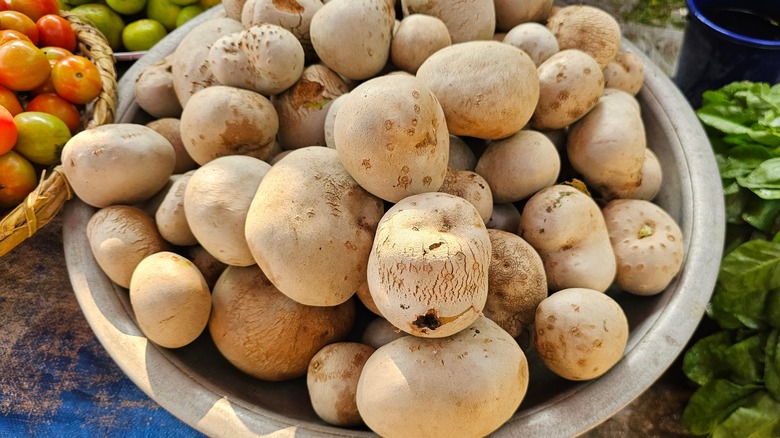10 Types Of Yams And How To Use Them
In case you missed out on botany 101, let's delve into the intriguing realm of tubers. This vegetable category is diverse and includes specimens like potatoes, taro, and yams. Tubers, which are essentially thick underground stems of above-ground plants, feature a network of hair-like roots beneath the surface that serve as energy reserves for emerging plant shoots. Nutritionally robust, they're loaded with complex carbohydrates, fiber, and an array of vitamins and minerals.
Now, let's zoom in on yams. They're grown all over the world and come in a variety of flavors, shapes, and textures. Take Ghana's white yam, for instance, a mild variety perfect for mashing, boiling, or frying. Or meet ube, the Philippines' vibrant purple gem, boasting a vanilla-like flavor that's the perfect addition to countless desserts. Between these standouts, there's a whole universe of other yams waiting to be explored. Join us on this yam-tastic journey, and let's uncover the fantastic world these tubers bring to the table.
American yam
If you're like most Americans, you'll probably be surprised to learn that the candied yams adorning your Thanksgiving table are actually sweet potatoes. True yams have a starchy, dry consistency with tough, hairy skin that requires Herculean efforts to peel. Conversely, sweet potatoes have a sweet, moist texture and a skin that slides off with relative ease.
The name confusion has an interesting backstory. Back in the 1930s, Louisiana farmers introduced an orange-fleshed sweet potato. To distinguish it from the golden variety people were familiar with, they started calling it a "yam." The term "yam" had already been floating around in the South as a nickname for sweet potatoes. It came into English by way of enslaved West African people who, upon seeing the crop, likened it to the yams from their homeland and started using words from their native languages like nyam, nyami, or nyambi to describe the crop. Marketers caught on to this and promptly slapped the new name on produce crates.
Despite ongoing efforts to clear up the linguistic mess, the mix-up is likely here to stay. Putting the name game aside, American yam varieties like Covington, Beauregard, and Orleans, have a lot to offer in the kitchen. Perfect for baking, steaming, and puréeing, these varieties shine in recipes like fresh yam casserole and candied yam casserole.
Japanese mountain yam
This yam variety, native to Japan, Taiwan, and Korea, also goes by the name yamaimo. It has a long, cylindrical shape and light brown skin speckled with hairs. In terms of taste, it leans slightly sweet and shares similarities with jicama. Once cut, its white flesh and slimy texture appear. Slimy isn't usually a positive descriptor, especially in the kitchen, but it's this texture that makes yamaimo so valuable in the kitchen.
Grated and cooked, yamaimo's sliminess serves as an excellent binder for savory pancakes like Japanese okonomiyaki. It also lends substantial thickness to radish-soy sauce broth and enhances the texture of traditional Japanese noodle dishes like hiyashi yamakake udon. While Japanese mountain yams have plenty of cooked uses (they also shine when pan-fried or sautéed), they do double duty as a raw ingredient. All you have to do is peel and thinly slice it into a salad. Or season the strips with shōyu (a type of soy sauce) or ponzu (a citrus-based sauce akin to vinaigrette) and savor them crudité style.
White yam (Ghana yam)
Originating from Africa, specifically West and Central Africa, white yams hold significant agricultural importance as a cash crop in the region. These yams are available year-round and exhibit an impressive size range, from potato-sized specimens to colossal ones weighing over 100 pounds. Characterized by a cylindrical shape, light brown, slightly hairy skin, and an easily peelable exterior, white yams house firm, white flesh inside. Despite their firmness, the texture is creamy, and the flavor is characterized by a mild and nutty profile.
White yams play a central role in the diverse cuisines of Ghana and other West African countries, making appearances in a range of dishes. Noteworthy dishes include ampesi, a delightful combination of boiled yams with a flavorful stew or gravy, and asana, a one-pot creation that brings mashed yams together with a medley of vegetables, fish, and spices. For those who crave a crispy treat, there are yam fries. They're exactly what they sound like — strips of yams seasoned with salt and fried in vegetable oil. Often served with pepper sauce, they're a popular street food in both Ghana and Nigeria.
Yellow yam
Similar to white yams, yellow yams are among the most widely cultivated varieties in Africa. They're also known as Guinea yams, or yellow Guinea yams, reflecting their place of origin and the distinctive yellow color of their flesh. You'll also find them in the Caribbean, hence their other nickname: Jamaican yams. Their vibrant hue comes from carotenoids, the same pigments found in carrots and sweet potatoes. While sharing a flavor profile reminiscent of sweet potatoes, yellow yams distinguish themselves by their larger size and bark-like skin, offering a starchy and dry texture.
Much like their white counterparts, yellow yams exhibit remarkable versatility in the kitchen. They can be prepared through boiling, baking, frying, or roasting. These yams also find their way into various soups, stews, and curries. Their adaptability makes them a staple ingredient in a number of African and Jamaican dishes. This list includes jollof yam, a yam stew made by combining boiled yams with shrimp, fish, and vegetables, and Jamaican yellow yam stew, a delectable porridge made with coconut milk, vegetables, and yellow yams.
Indian yam
Similar to many yam varieties, the Indian yam is known by several names. These include true yam, yampee (also spelled yampi), tropical yam, igname, and cush-cush (also spelled kush-kush). True to their name, tropical yams thrive in the hot and humid parts of Asia, Africa, and Latin America. They feature a rough, bark-like dark brown skin that's challenging to peel in its raw state, but that softens with cooking. Due to their dry flesh and relatively bland taste, recipes incorporating these yams are designed to impart both flavor and moisture.
In the Caribbean, mashed yams are a cherished comfort food. Far from a simple side dish, mashed yams are combined with a sautéed mixture of onions, hot peppers, herbs, and seasonings to create a filling meal perfect for any time of day. Meanwhile, in West Africa, tropical yams are peeled and cubed, becoming a key ingredient in ragout d'igname, a hearty stew featuring beef, tomatoes, and onions.
Filipino purple yam (ube)
If there were a yam popularity contest, ube would easily take the crown. While it's long been a go-to ingredient in Filipino desserts like ube-macapuno cake and halo-halo — a colorful parfait-like concoction made with shaved ice, sweetened condensed milk, ube jam, and other sweet additions — it only gained widespread popularity in the United States in the mid-2010s. Manila Social Club, a Filipino restaurant in Miami, is often credited with introducing ube to American consumers in 2015 through their $100 gold-ube donut.
The charm of this purple-fleshed yam quickly captivated other American eateries and home chefs. Its vibrant color not only looks stunning on camera but its subtly nutty, vanilla taste makes it a versatile ingredient for various treats. For instance, there's purple ube halaya, a jam-like spread that'll add a twist to your morning toast. Or why not try an ube latte? It's an eye-catching beverage that'll have you bidding your regular matcha adieu. And let's not forget the desserts — ice cream, brownies, and mochi are just a few of the sweets made better by this fantastic yam.
Elephant foot yam
With its massive size and disc-like shape, the elephant foot yam bears a striking resemblance to the extremity it's named after. The elephant foot yam, which is also known as suran or jimikand, is native to Southeast Asia and India. Like other yams, it has several culinary applications. A common preparation involves deep-frying them with onion, tomato, and spices to create a flavorful curry. Similarly, they make for a delicious (and healthy) snack when battered and fried. Alternatively, they can be used to whip up yam bharta, a mash combining boiled yams with garlic, green chilies, and lemon juice.
While the earthy, slightly nutty-tasting flesh takes the spotlight, don't overlook the leaves. A 15-minute soak in salt water and a quick rinse make them ready for your next stir-fry masterpiece. Beyond the kitchen, elephant foot yams play a key role in Indian medical systems like Ayurveda, Siddha, and Unani where they're used to help manage issues such as coughs, hemorrhages, and abdominal pain.
Chinese yam
Due to their similar shape, size, and color, Chinese yams — also known as cinnamon vines thanks to their cinnamon-scented flowers — are often mistaken for Japanese mountain yams. Despite the understandable confusion, a closer look reveals distinct differences between the two. Chinese yams are typically short and stout, while Japanese mountain yams are long and slender. Additionally, the skin color varies, with Japanese yams sporting a brown coat and Chinese yams displaying a skin closer to yellowish-light brown.
In terms of applications, Chinese yams play a significant role in traditional Chinese medicine. Practitioners recommend them for promoting digestive health, boosting energy, and reducing inflammation. Beyond addressing daily health concerns, Chinese yams are also suggested for alleviating symptoms of asthma, diabetes, and menopause. In the kitchen, their mild flavor, firm texture, and slightly slimy consistency make them versatile additions to soups, stir-fries, and dumplings. They can also be enjoyed raw, either pickled or shredded with cabbage, to create easy and tasty side dishes.
Lesser yam
Despite the unassuming name, lesser yams have a lot going for them. This yam, primarily grown in Vietnam and India, was among the first cultivated yam species. Nutritionally, it's packed with dietary fiber, vitamin C, vitamin B6, potassium, and manganese. Beyond its nutritional perks, it stays fresh for up to six months, making it a strong candidate for tackling food insecurity in Southeast Asia.
Setting aside its impressive background, lesser yams are sweet with a pleasant flavor reminiscent of sweet potatoes or chestnuts. They are versatile and can be boiled, baked, or fried — similar to how you'd prepare potatoes. They also mash well and can be baked whole, topped in the style of jacket potatoes. In Vietnam, they shine in dishes like chè củ từ, also known as lesser yam pudding. To make this dessert, boiled cubed yams are mixed with water, sugar, and tapioca starch, resulting in a gelatin-like treat that can be enjoyed hot or cold.
Air potato yam
Remember when we shook up your understanding of tubers, explaining that those holiday "yams" are actually sweet potatoes? Well, brace yourself for another revelation. Air potatoes, despite their seemingly straightforward name, aren't potatoes at all; they belong to the yam family. This species originates from Asia, the South Pacific, and northern Australia, but female air potato yams have found their way to the United States. Unfortunately, they're invasive and are considered unsafe to eat, so your only chance to try them might be during a vacation.
Speaking of which, you'll probably recognize air potato yams as soon as you take the first bite. While boiling and seasoning help transform their flavor, these yams are intensely bitter. Aside from removing some of the acidity, boiling also helps reduce the sliminess. Once the bitterness and sliminess are taken care of, air potato yams prove versatile, performing well when fried, sautéed, or roasted. In Asian cuisine, they're a popular addition to savory pancakes like okonomiyaki. Additionally, they can be incorporated into miso soup, curry, and tempura.
